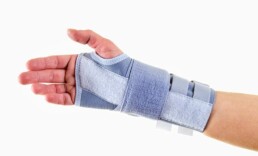On a daily basis, we don’t give much thought to our wrists, unless we are putting on a bracelet, affixing cufflinks or buttoning a sleeve. They are simply connectors, bringing more important body parts – hands and arms – together so they can do their work.
We do sit up and take notice, however, if those wrists begin to hurt. It’s only then that we realize how important they are to the smooth functioning of our upper extremities and how frustrating it can be when they aren’t working properly. Carpal tunnel syndrome (CTS) is a common reason for wrist pain, so it’s worth examining in more detail.
Carpal Tunnel Syndrome Explained
Carpal tunnel syndrome results from the compression of the meridian nerve, a nerve on the palm side of the wrist. The meridian nerve is located in a “tunnel” created by a wrist ligament and the carpal, or wrist, bones. The tunnel, which is about the width of a thumb, is also crowded with the tendons that allow us to bend our fingers. Compression is generally caused by pressure on the nerve due to crowding or irritation.
What Causes Carpal Tunnel?
A frequent culprit is continued finger use, especially in situations that include vibration, and extreme wrist positions can contribute to CTS, as can repetitive motion. In today’s technology-focused world, we tend to associate CTS with working at a keyboard all day, but people working on assembly lines are three times more likely to develop it.
Other conditions that may lead to carpal tunnel syndrome, include:
- Wrist injuries, such a sprains and fractures;
- Swelling and inflammation of the wrist tendons;
- Metabolic or hormonal changes, including pregnancy, menopause and thyroid imbalance;
- Scar tissue from repeated traumas;
- Degenerative or rheumatoid arthritis: and
- Diabetes.

Prevention: Minimizing Stress to Hands and Wrists
There is no surefire way to prevent carpal tunnel syndrome, but there are actions you can take to minimize the stress to which you subject your hands and wrists as an attempt to keep it from developing:
- May the force NOT be with you. Reduce the amount of force you use when doing work with your hands; most of us apply more than is necessary. For writing, use soft-grip implements.
- Ergo, it’s ergonomic. Have your work station assessed from an ergonomic point of view to ensure that is suited to your height, posture and work you do.
- Wrist readjustment. At a keyboard, keep your wrists extended, rather than flexed upward or downward to ensure that you don’t put undue strain on your nerves and tendons.
- Perfect your posture. Keeping your torso, neck and shoulders aligned can help ensure that you position your hands and wrists properly.
- Create warmth. Hand pain and stiffness happen more easily in the cold, so keep your work environment warm. If you can’t adjust the temperature, wear gloves to warm your hands and wrists.
- To your health. Overall good health is important to keeping diseases that may lead to carpal tunnel syndrome at bay, so take good care of yourself.
Signs and Symptoms of Carpal Tunnel Syndrome
So, what does carpal tunnel feel like? If you experience any of the following, they may be signs that you are suffering from carpal tunnel syndrome:
- Pins and needles that affect the thumb and first two fingers;
- Numbness in the wrists or fingers;
- A clumsy feeling in the affected hand; or
- Weakness of the hand or in grip strength.
You may notice the feelings more clearly at night and may be awakened by the pain.
Diagnosing Carpal Tunnel Syndrome
Oftentimes, your physician or your physiotherapist can diagnose CTS without much trouble if you have the standard carpal tunnel symptoms, but there are also some tests that can be used to confirm its presence, including:
- Finger and thumb grip strength testing;
- Wrist and hand range of motion testing;
- Reflex hammer testing; and
- Electrical studies showing nerve transmission.

How to Treat Carpal Tunnel
Carpal tunnel syndrome doesn’t require surgery, except in the most extreme cases. Initially, your physician will suggest physiotherapy as a carpal tunnel treatment. There are a number of simple carpal tunnel exercises that can relieve the pain and strengthen the wrist to prevent a recurrence of CTS.
Depending on the severity of the compression and inflammation, your physician may suggest wearing a resting wrist brace at night to prevent your wrist from assuming an injurious position and/or a working wrist splint to wear during the day. A steroid injection may reduce inflammation and its effects may last for weeks or longer.
Carpal tunnel syndrome is a minor injury with major consequences for our daily routines. It’s wise to take action as soon as symptoms appear so that the injury doesn’t progress. Ice the affected area and take frequent work breaks, and seek treatment if it continues.
